This post is based on our experience traveling by public transport from Gabon (Ndende), across the border at Doussala, to Republic of Congo (Dolisie) in July 2023.
There are a couple of open border crossings between Gabon and Republic of Congo (RoC). There’s one in the west of Gabon going from Franceville via Leconi to a very small town in RoC called Okoyo (I think). Apparently the road conditions on that route are pretty good but transport is very very sporadic (not that there was much more on the route we took either, tbh).
We opted to go from Ndende in Gabon, to Dolisie in RoC, crossing at Doussala/Ngongo. This is supposedly the better-known route, and is partially on what’s called a ‘National Highway’ (but that doesn’t mean much). Plus, from Dolisie we’d have the option of easily picking up onward transport either to Pointe-Noire or to Brazzaville.
Traveling by road from Gabon to Republic of Congo requires some planning, a lot of patience (and time), and could possibly result in some severe headaches if things don’t go 100% according to plan (and, ah, they won’t). I’d have felt more confident about the trip myself if I could have actually read a first-hand account. Preferably one that didn’t make it seem too daunting, anyway – hence this post, in case you’re wondering.
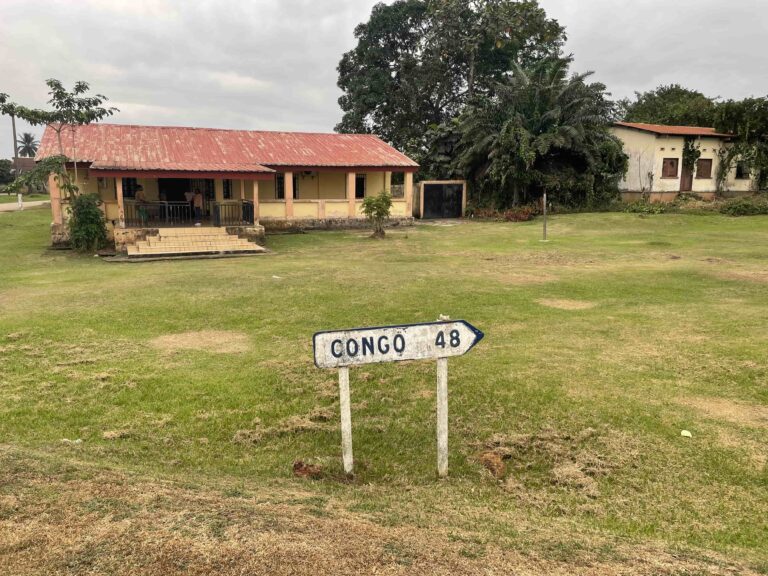
This post isn’t a guide so much as an outline of our route and how it went. It’s supposed to encourage anyone else in two minds about taking it on, as we initially were. Remember that things change around here all the time. If you follow this route your experience will probably be similar to ours but not exactly the same. There could be more (or fewer, or different) police checkpoints, you may or may not stay a few hours or overnight at a checkpoint for your driver to sleep, your driver may or may not be recklessly intent on vehicular manslaughter, the police might be a huge pain – or not, and so on.
How smoothly you get through is just luck of the draw and will mainly depend on who you meet, how quickly your car fills up, who is in it, and all kinds of stuff like that.
The moral of the story is: it can be done. It’s an interesting and exciting journey that I honestly will not forget. Ever.
So, if you ever thought about crossing the border from Gabon (Ndende) and Republic of Congo (Dolisie) by road, then read on.
Before you go
You need to get your Congo visa in advance, either in your home country or a in neighboring one on your way. Visa requirements in this region are often obscure and subject to change. Don’t count on getting your visa in the country right next door, either. Make sure you can actually get the visa you need in the country where you’re planning to pick it up. Side note: Embassy/consulate locations change from time to time as well.
We picked up our RoC visas in Yaounde, Cameroon. Expedited, it took about three days. At the time, it was definitely possible to get the RoC visa in Libreville (Gabon), too.
Keep the weather in mind. We traveled in the dry season and the roads were a rutted, potholed mess – but passable. The car we were in was not robust, to understate its condition. I thought we’d would never make it in places, but we did, because there was no mud. We nearly choked to death on the dust since the car windows wouldn’t shut, but that was the worst of it. And on the bright side there was no chance of driving at high speeds, which is fine by me. In the rainy season the trip will most likely take a lot longer, probably a couple of days, and you’ll need to sleep in the villages along the way from the border to Dolisie.
In West and Central Africa the security situation can change, sometimes quickly. For example there was a coup in Gabon just weeks after we left. They shut the borders – no matter who was already inside (and while they were at it they changed their visa policy, twice). Check the latest travel advice from your government and make sure your insurance is up to it.
Make sure you have local currency and ideally USD in case you need more. You’re not going to find ATMs anywhere around here. These two countries use the same currency: Central African CFA (XAF). It’s the same value as West African CFA (XOF), but if you’re carrying West African CFA you will have to change it. There were money changers on the RoC side of the border in Ngongo.
Make sure your vaccines are up-to-date and you’ve got your International Vaccine Card with you to prove it. Otherwise you’re just opening yourself up to bribe-attempts from the police.
The border is open during regular daytime hours. As with any other border-crossing day, just try to get an early start. You can try as hard as you want, but likely you will be hindered every step of the way.
The route
We started this trip in Ndende, Gabon. There is a police post there where we did the formalities and got stamped out of Gabon.
In Ndende, we found shared transport to the frontier town on Gabon’s side, called Doussala. The same ride drove us right across the border (it’s not noticeable, other than the checkpoints) and dropped us in Ngongo which is simply the frontier town on RoC’s side of the border.
In Ngongo, we did the bureaucracy, stamped in to RoC, and picked up onward transport to Dolisie. From there it’s a long trip mostly through forest and a few smaller villages. Besides one other car that left the border shortly after ours, there was no other traffic.
The whole thing took a bit less than 24 hours, in the dry season. It’s not that far (about 280 kms) but there’s an incredible amount of waiting around, all the checkpoints, and general shenanigans to take into account.
Ndende to the border (Doussala)
Coming from Lambarene it took a while to reach Ndende, so when we did we stayed the night. There’s a guesthouse called Divine that ‘everyone’ stays at but when we were in town it was full, of police for some reason. So, we went to another one called Nilson (or else that was the manager’s name and the hotel itself was actually called Eden).
The Nilson/Eden appeared to be abandoned and I think it really was. Yet Nilson, once we located him by calling the number on a piece of paper stuck to the window, and his inexplicably large staff, put us in a room and scrounged up bedding and even a lightbulb. It’s well on the outside edge of town so take care about walking after dark if you’re going back and forth.
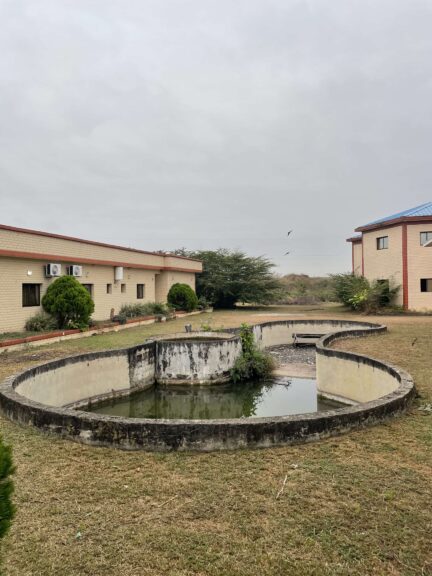
Ndende is a small town but there are a few places to get some chicken and rice. It’s friendly. We wandered around to the road sign for Congo 48 (km), and sat in a little streetside bar for a beer. There are no ATMS.
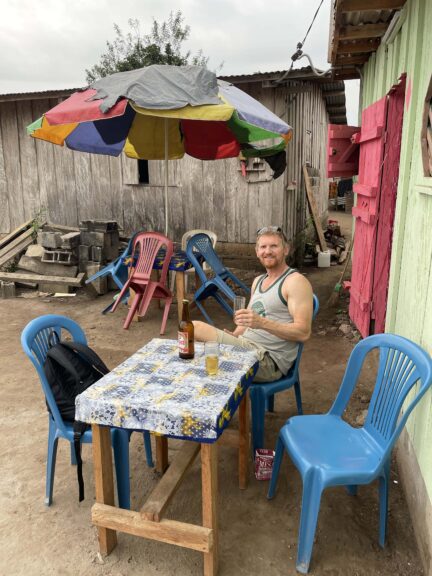
From Ndende we set about organizing our ride to Doussala. Transport runs from next to the Total petrol station near the market. Nilson and his friend who I’ll call the Driving Instructor, since he was driving a car with a sign on the door and an extra brake pedal on the front passenger side, helped us find transport going to the border the next day.
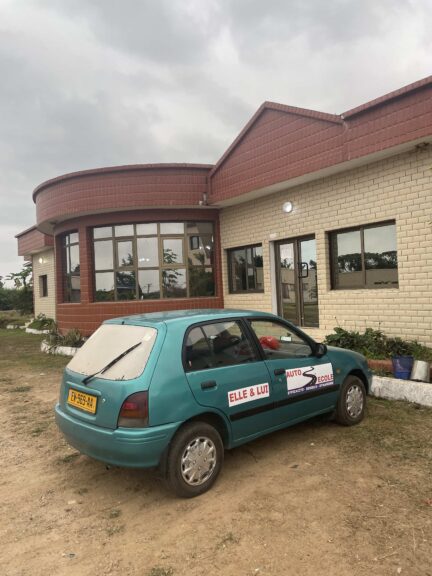
The police station is marked on Maps.me. We went over early the next morning. The Driving Instructor told us it opened at 8 am but no officer appeared until around 8.30. This officer took our documents and filled out the details in his giant ledger, but it seemed he did not have the authority to actually stamp our passports. We had to wait another half hour or so until ‘Mon Commandant’ as everyone called him (he was The Stamper to us), turned up with the stamp and took care of business.
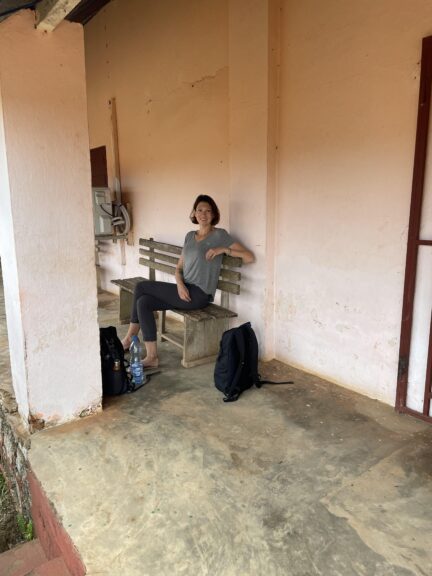
From immigration it’s a short walk to the garage next to the Total petrol station. Then we waited for Josef, the driver we’d met the previous day, to load (and by that I actually mean drastically overload) a pickup truck with passengers and their luggage. Seven passengers in the double cab, to be exact, and six more on the truckbed.
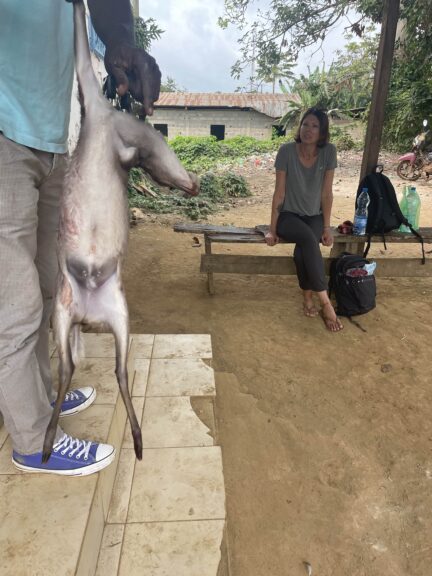
We set off around 10.45 am, which was much later than Josef had originally promised we’d leave. A piece of advice: on the way to the border, make friends with your fellow passengers. These are the people whose laps you’ll wind up sitting on who you’ll be traveling with in a small car for hours to Dolisie. We found it helpful to be able to communicate at least a bit, with some of them, since otherwise we had no idea what was going on half the time. They also knew how much the transport from the border should cost, and it’s good to know that ahead of time before the drivers have you.
Crossing the border
The share taxi/pickup went through three checkpoints on the way to Doussala. At each checkpoint the police wrote and rewrote every passenger’s details down in huge ledgers. It took around two and half hours from Ndende to reach Doussala and so the border. The same ride took us across no man’s land to Ngongo on the RoC side, where everyone climbed out and Josef drove his truck straight back to Gabon.
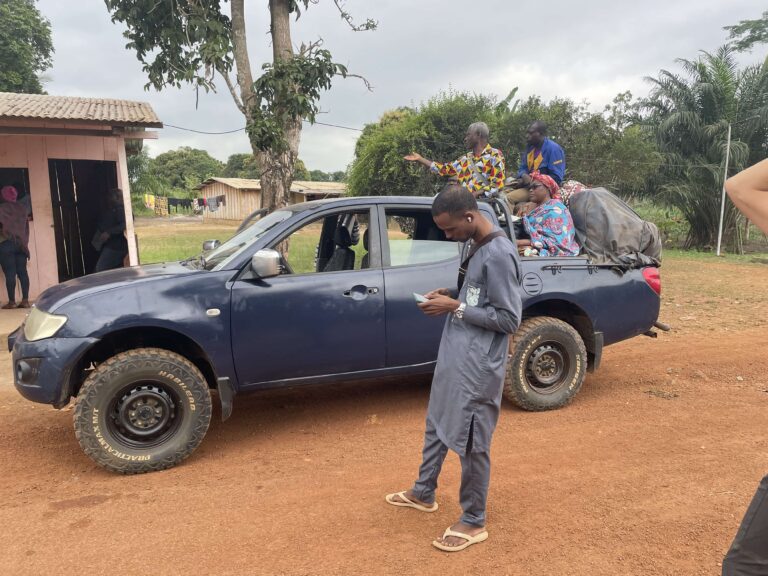
![]()
The Republic of Congo border is a bit of a spectacle. Before even reaching Immigration we had to register twice with two different police, then the army, and then the gendarmerie. Each office was nothing more than a room in the small clutch of buildings in a clearing in the forest with police, money changers, and potential drivers milling around. At one point a friendly and reasonable police officer (rare, in these parts) called her English-speaking son in Brazzaville and brought him into the fray on WhatsApp. Finally they sent us to Immigration for stamps, and then a customs check where they partially unpacked our backpacks. The actual border crossing took around one and a half hours.
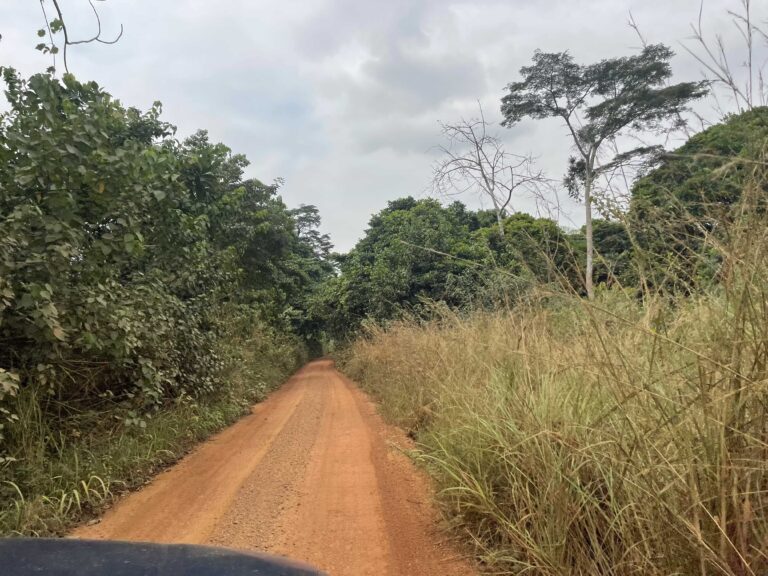
It’s an interesting border to cross and an adventurous journey to Dolisie awaits. Start as you mean to go on, I always say.
Bienvenue a Congo!
The border (Ngongo) to Dolisie
There were several cars waiting at the border post, bound for Dolisie and the villages along the way. They leave when they are full – six passengers and the driver – and not a second before. We knew this and didn’t love it either, as getting going fast as possible to ideally get through by dark, is key. It’s also not gonna happen, but still, we wanted to leave sooner rather than later.
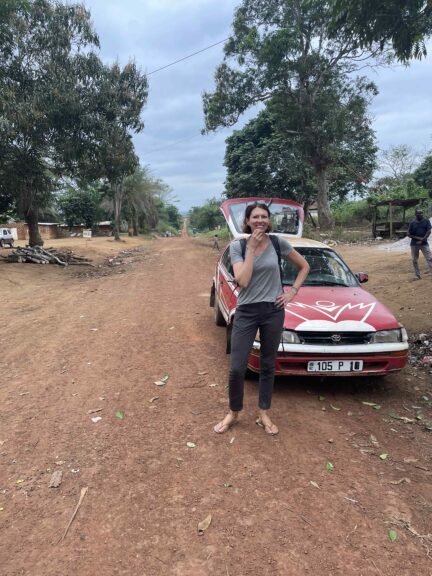
Two of the other passengers from our first ride out of Gabon, one from Mauritania and the other from Central African Republic, both named Mohammed, seemed to feel the same way. So after some discussion that included the friendly police officer and her iPad with her son it, we and the two Mohammeds agreed to split the two remaining places in one of the cars, and left pretty quickly. Splitting the ride made almost no difference in terms of getting to Dolisie in any kind of reasonable timeframe, but it did make the trip more comfortable since we didn’t have to put four people in the back and two up front with the driver.
We left Ngongo around 3 pm and finally arrived in Dolise at 3 am. In other words, 12 hours to cover 255 kilometers, mainly thanks to the police along the way, with a shout out to the terrible road conditions. And, our driver insisted on stopping here and there (well after dark, in the forest) to ‘hide’ from the police at upcoming checkpoints in the hope that they’d be too drunk to stop us by the time we passed by. That didn’t exactly help speed us on our way either.
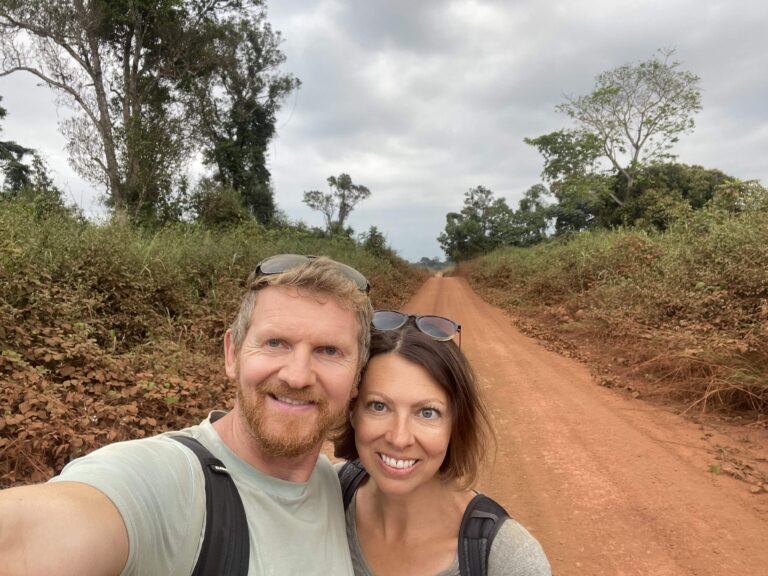
During the course of the drive we stopped at around seven checkpoints. At each one, we all got out of the car and the police wrote down the same details – when they were capable of writing that is – more than one of the officers was drunk. Not to mention there was often no electricity and this was all carried out in the light of a lantern or a fire. I cannot overstate the pointlessness of these repeated registrations.
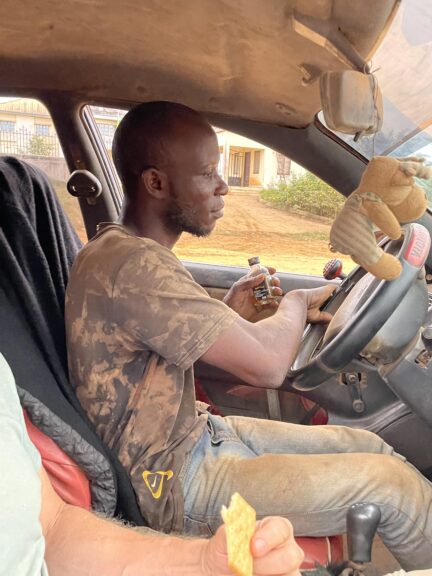
The police, who looked for any excuse to hassle our driver and fellow passengers, overlooked what I thought was a very obvious one: our driver had a little bottle of whiskey with him and helped himself from time to time throughout the journey. Once I saw him take a swig right in front of a whole group of gendarmerie. Nobody blinked. Surprisingly, none of the police tried to extract bribes from us – but our fellow African passengers had to pay a lot. Mohammed from Mauritania didn’t have a yellow vaccine card, for example, and I’m pretty sure it wasn’t because he’s an anti-vaxxer. He had to pay dearly for that.
Dolisie and moving on – Pointe-Noire or Brazzaville
Depending on when you arrive in Dolisie, in theory you could get a bus straight on to Pointe-Noire as it’s only a few hours away. We arrived in the middle of the night and were not just worn out, but also filthy so we stayed a couple of nights before getting a bus to Brazzaville. Dolisie is pretty chill, we liked it.
We stayed at La Glorette Hotel, recommended to us by Steven. Who’s Steven, you say? He’s an extra passenger we picked up in a village in the forest somewhere along the way. Steven rode on the roof of our car for quite some time, and then when the dust eventually got to him, he slithered in through the window and squeezed into the front seat with the driver, announcing ‘C’est le Congo’ as he did so.
The driver, Steven, and the Mohammeds kindly went out of their way to drop us off at La Glorette. We were happy, because that late at night the entire town was otherwise deserted and we’d have got stranded if they’d just left us at a garage. They even woke up the night guard and the receptionist for us, and stayed til we got sorted.
The rooms upstairs at La Glorette aren’t too bad (maybe avoid the downstairs rooms). It was also cheap, and friendly – the receptionist helped us get organised with our onward bus tickets and information, and kindly tolerated some pretty atrocious French.
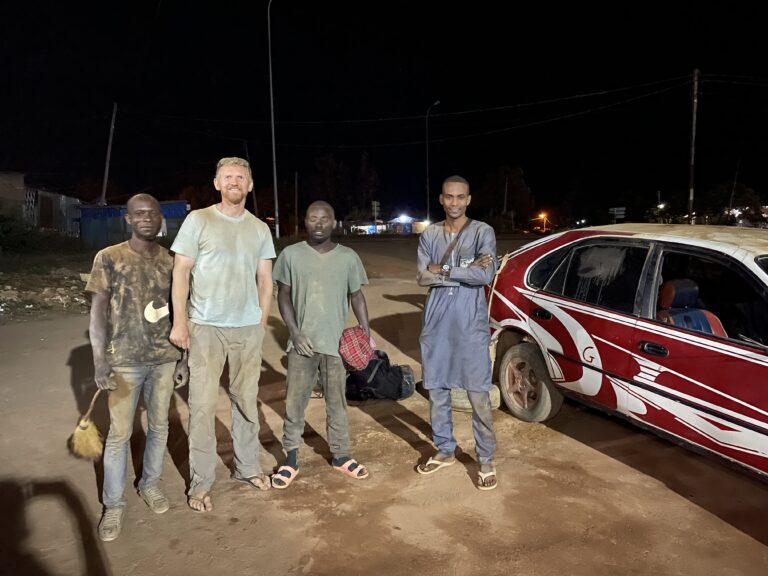
Big buses run a couple of times throughout the day and it took nearly a day to get from Dolisie to Brazzaville what with roads, traffic, and checkpoints. The route goes through the Poole region and a lot of governments still warn their citizens to stay out of there (because of Ninja rebel activity), but as far as we’ve heard, it’s not such a big deal anymore.
Read More
For more of our adventures (and misadventures) as we travel from Cameroon to Japan, check out the rest of my stories from the road.
We’ve crossed a lot of borders by all sorts of random transport. Have a look at our border crossing reports and travel guides for strange stories and sage advice.
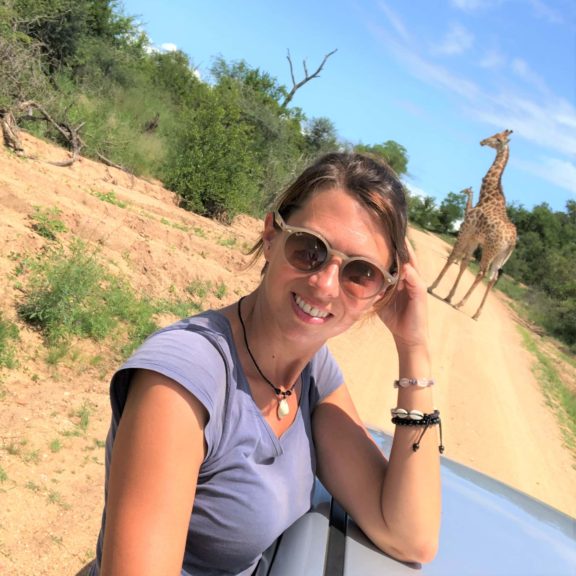
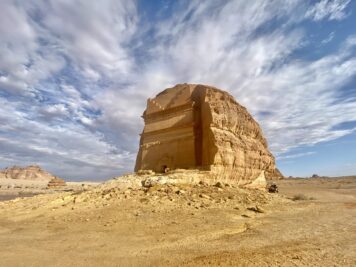
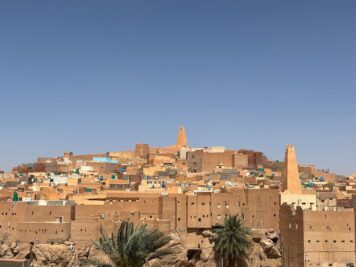
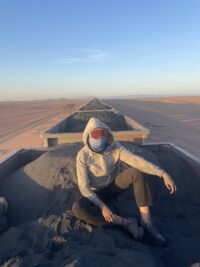
This Post Has 6 Comments
Excellent. Great report and a good yarn. You have always liked a good border crossing. Enjoyed these two posts very much. Keep going!
Thanks Andrew!
Hi Sarah , can you advise what the Cost of The ROC visa was in Yaounde please….thanks pete.h, p.s asking for a friend who is travelling from london to cape town on a motorbike, currently in Nigeria….
Hey, offhand I’d say around 70 USD, maybe less. Types and costs were all posted.
Hi Sarah , this just gave me much needed clarity as I intend on backpacking this year .
The Gabon post brought me here and I realized I could do Cameroon , then Gabon and then Congo Brazzaville onward to the DRC and my next location than back tracking from Gabon back to Cameroon, thank you .
Safe travels and keep on writing
Hi, you can, and that sounds good! Enjoy it, and safe travels you too:)